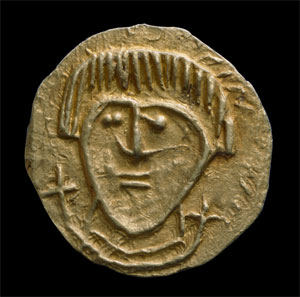
The Crondall Hoard remains the most important evidence for the start of English coinage. The hoard was buried sometime before AD 650 and includes the earliest Anglo-Saxon coins. This was the first coinage produced in Britain after the departure of the Romans two centuries before. The new coins were modelled on those from France, but also looked back to Rome for inspiration.
The hoard contained over 100 pieces. Some scholars have suggested that its value might have been 100 gold shillings (“thrymsas”), an amount equal to the compensation for taking a human life according to a law code of the time. Scholars argue about how these coins were actually used.
Eighteen-year old Charles Lefroy was on a shooting trip with his gamekeeper in Crondall, Hampshire when he noticed a heap of small metal objects where people had been cutting turf. Stopping to examine them, Charles found the gold coins along with two jewelled ornaments and chains. That was in 1828. The coins were bought for the Ashmolean in 1944, at that key moment in British history, to commemorate Sir Arthur Evans.
Of the 98 gold coins in the hoard some came from the Continent, for example from Italy and France/Netherlands, but no less than 73 are English. The English coins were mostly struck by kings and (probably) bishops from London and Kent. Three of the coins were unofficial issues made to look like coins. The hoard originally also contained some coin blanks and one forgery. Two pieces of jewellery and chains, perhaps from a container for the coins, were found too, but no one knows where they are now.
The designs on the coins are remarkably varied and often indicate royal or church power. Some are a mystery. The simple style of the facing head on is how bishops and saints are drawn in manuscripts.
Click to enlarge

Hoard of early Anglo-Saxon coins found at Crondall, Hampshire

One of the coins from the Crondall Hoard
Further Information
Find out more about:
- British Coinage at the Ashmolean
- British Anglo-Saxon Collections at the Ashmolean Museum
- British Collections Online - searchable database of the collection
22 May 2012